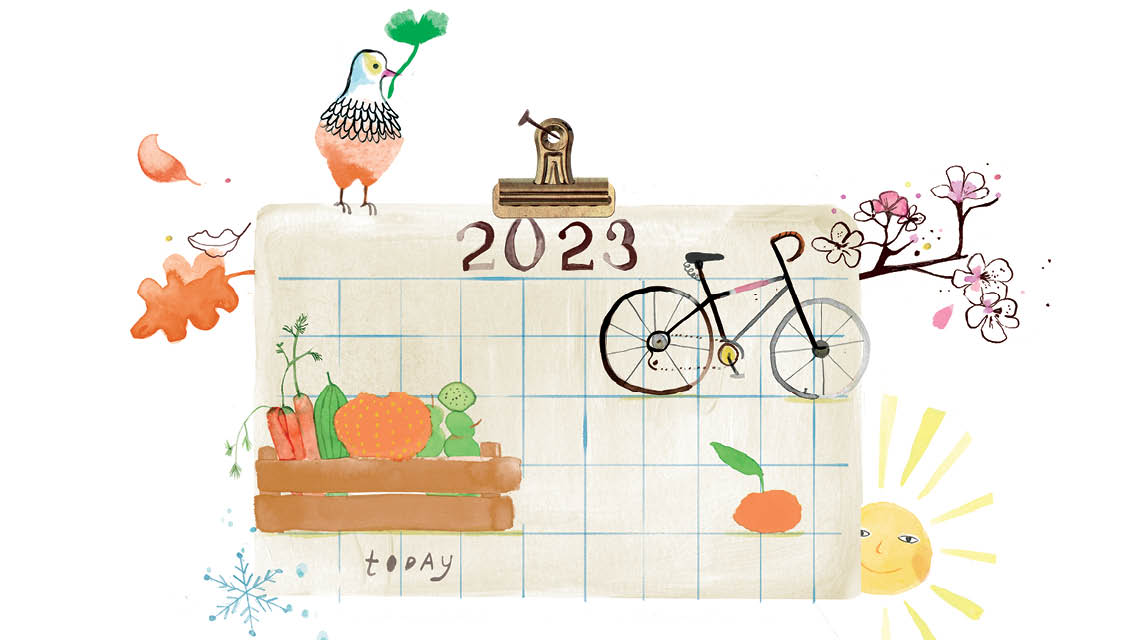Many of us greet each new year with improvement on our minds.
Maybe we want to save for a down payment, run a marathon, or cut back on booze. Or we make more general (but still worthy) goals: Drink more water, get eight hours of sleep each night, or reconnect with friends.
The New Year can be a good time to take stock of what’s working in your life, according to Seattle-based productivity and mindfulness coach Sarah Steckler. “We are cyclical creatures, and the seasons tap back into our own cycles,” she explains.
Many of us also crave structure and guidance around the New Year, which is one reason Steckler recommends constructive to-do lists and calendars. These offer a physical reminder of the issues you want to address and practices you can add to improve health, productivity, and quality of life.
This helpful calendar is designed to support your health and well-being with reminders and ideas — regardless of your goals. Think of it as a mashup of a to-do list and a goal-setting session. Take what you need, leave what you don’t, and bring some seasonal organization to the year ahead.
January, February, and March
Take care of your taxes. They’re one of life’s must-dos, so get them out of the way. For the new year, consider trying something new financially, such as an envelope system, a digital budget, a fresh investment strategy, or a different plan for tackling debt. (Get more tips on financial health at “Mindful Money“.)
Deep clean the kitchen. You can do this at any time of year, but most kitchens could use a good scrub after the holidays. Be sure to clean inside your oven, refrigerator, and microwave, and don’t miss surfaces and light fixtures.
Start a weekly ritual. What’s one thing you could do 52 times this year to take better care of yourself? Think outside the bubble-bath box. Maybe it’s an art class, or a weekly coffee date with friends. Keep in mind that scheduled things tend to stick.
Plan your garden. Order seeds, design a raised bed, or learn how the heck to keep a succulent alive. Days will be getting a bit brighter and warmer, and it’s good for your mood to think green. No matter how big or small the project, growing something is satisfying. (Learn more about why gardening is good for you at “Beyond the Harvest: Five Ways Gardens Support Your Health“.)
Visit the dentist. And while you’re at it, take another look at your health benefits for the year and make sure you’re not overlooking good deals, like discounts on health-club or gym memberships or health products.
Rethink your “foodprint.” The beginning of the year is a great time to try a meal-subscription service, line up a community-supported agriculture (CSA) membership, or join a local co-op. Consider what you’ll really use; a full third of the global food supply ends up in the trash. (Get tips for reducing your household food waste at “14 Tips to Reduce Household Food Waste“.)
April, May and June
Prep your pets for the outdoors. If you have a four-legged friend who spends time outside, now is a good opportunity to take precautions — like giving heartworm and tick-and-flea medication — to keep your pal healthy and safe for the season.
Spring clean your closet — and your phone. You’ve heard about taking stock of your clothes and donating, recycling, or tossing things you haven’t worn in a year. That’s a good idea — and so is a digital refresh. Delete old apps with expired trials, those you haven’t used in a while, and any photos or old messages you don’t need. It’s also a good time to evaluate your use of technology and consider a more mindful approach. (Get our tips for breaking free from tech addiction at “How to Break Free of Tech Addiction“.)
Consider your community. During the first half of the year, research issues in your area to identify those causes and organizations that align with your values and need your help — whether it’s your time and energy or a financial contribution. Recurring donations are more valuable to most nonprofits than a one-time gift, so consider setting up monthly giving for causes you’re passionate about.
Tune up your gear. Schedule a bike tune-up a week or so before you’re ready for outdoor riding — bike shops are notoriously busy in the spring. If you prefer to hit the pavement or trails on foot, figure out how many miles are on your kicks. Running shoes should be replaced roughly every 500 miles. If you have an old pair, check to see if any of your local shoe stores have recycling programs.
July, August, and September
Schedule annual health screenings like prostate, breast, and vision exams if they’re due. This is also a good time for parents to schedule pre-fall-sports physicals for their school-age children.
Tackle deeper-cleaning projects. With spring cleaning behind you, now is the time to clean the carpets, tune up your HVAC system, and address any pressing outdoor house maintenance. Long days mean lots of daylight to attack larger to-dos.
Fine-tune your self-care routine. Successful goals are flexible, Steckler notes. She recommends that clients practice daily or weekly “brain dumps,” or a few minutes of freewriting, to reflect on what worked in the past week and what needs more attention. “It’s a simple way to declutter your ideas,” she says.
Prep your home for winter. Even if you usually wash your windows in the spring, this is a good time to wash them again, so you’ll be able to let the winter light in. If you live in a colder climate, consider replacing weather stripping or adding insulation to help save energy. (Get more tips for winterizing your home at “13 Tips to Winterize Your Home“.)
October, November, and December
Pickle or ferment something. Fermented foods are good for your gut, and no fancy equipment is needed. Take a trip to a late-season farmers’ market and try pickling veggies to keep on hand for the shorter days ahead. Pickled cucumbers, carrots, green beans, and beets all make for a snappy addition to winter meals. (Try our recipe for Quick-Pickled Veggies.)
Boost your immunity. Clean out your medicine cabinet and stock up on immune-system supporters, such as vitamin C and oregano oil. If you get an annual flu shot, try to schedule it by the end of October.
Level up your cozy. You may naturally feel pulled to bed as the days get darker, so consider adding a weighted blanket for added relaxation or a sunrise lamp for brighter mornings. Still not sleeping well? Learn how to reclaim your sleep rhythm at “Reclaim Your Sleep Rhythm“.
Take time to volunteer. This can be a busy season, and it’s helpful to step outside of your bubble to keep things in perspective. Whether it’s serving a holiday meal, asking a shelter about winter donations, or running a toy drive, helping others is guaranteed to end your year on the right note.






This Post Has 2 Comments
Great idea! Would love to see it taken 1 step further next year – perhaps offer a digital calendar where you could type in or drag/drop symbols to specific dates to schedule these items for yourself and save/print? Thanks for a great magazine! It’s the only one I subscribe to.
Love this! Would love a printable version or way to “keep track” and stay the course!